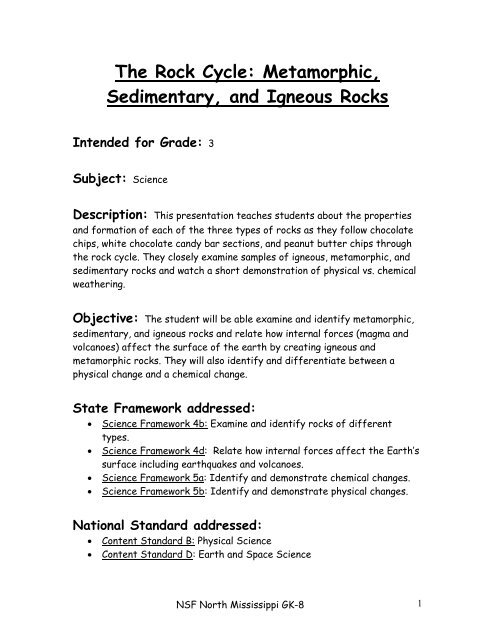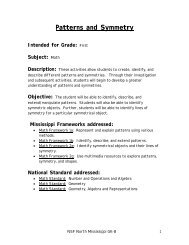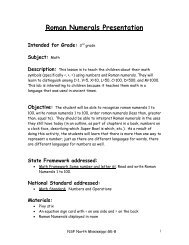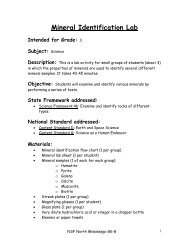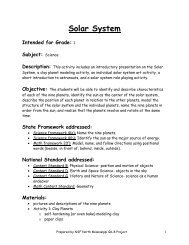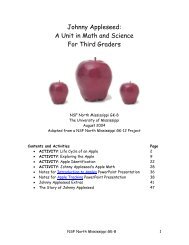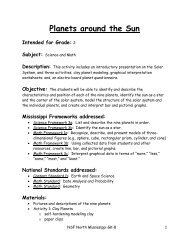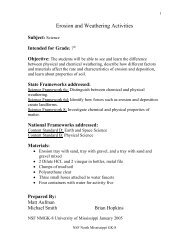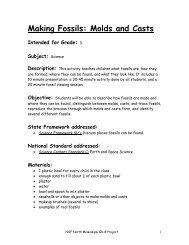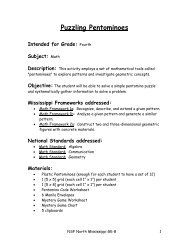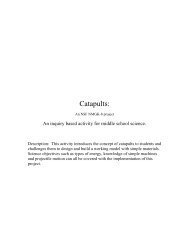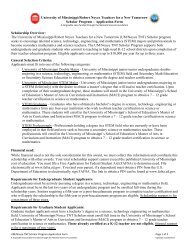The Rock Cycle: Metamorphic, Igneous, and Sedimentary Rocks
The Rock Cycle: Metamorphic, Igneous, and Sedimentary Rocks
The Rock Cycle: Metamorphic, Igneous, and Sedimentary Rocks
- No tags were found...
You also want an ePaper? Increase the reach of your titles
YUMPU automatically turns print PDFs into web optimized ePapers that Google loves.
squish <strong>and</strong> squeeze the rocks <strong>and</strong> then place the bags backbeneath their legs.16. Now ask the students how sedimentary rocks form <strong>and</strong> wherethe sediments come from.17. To explain the weathering process, bite the apple again (on theopposite side from the previous bite). Explain that sometimesrocks are weathered into sediments by being broken, cut, orscratched, similar to how you just broke off a piece of theapple by biting it. This is called physical weathering.18. Turn the apple around <strong>and</strong> show the students the bite that wastaken out of the apple before the activity was begun. Ask thestudents what they see. By now, that bite should be brown. Askif anyone knows why the bite is turning brown? (Because it isbeginning to decompose). Explain that chemical weatheringoccurs when things decompose or dissolve. Sometimes differentminerals that compose a rock may dissolve if they come incontact with water (rain). This can create sediments <strong>and</strong>solutions, both of which are necessary for the formation ofsedimentary rocks.19. Explain that sedimentary rocks can be composed of shells orplant fragments, minerals that precipitated from solutions, orworn rock fragments <strong>and</strong> mineral grains.20. Show examples of sedimentary rocks. Point out what they aremade of <strong>and</strong> any layering that is present. Pass them around theclassroom <strong>and</strong> allow the students to closely examine the rockswith magnifying glasses.21. While the students are busy looking at sedimentary rocks, goaround the room <strong>and</strong> help each group individually with the nextfew steps:a. Have the students carefully remove the wax paper withthe metamorphic rocks inside.b. Have the student with the chocolate chip rock place therock on the desk <strong>and</strong> remove the top piece of wax paper.c. Have the student with the white chocolate c<strong>and</strong>y barrock remove the wax paper <strong>and</strong> place the rock on top ofthe chocolate rock.d. Have the third student do the same, so that all threerocks are now layered on top of each other.NSF North Mississippi GK-8 7
e. Explain that, in reality, weathering would break downthese metamorphic rocks into tiny sediments that couldbe blown by the wind or carried away by a stream orriver. Eventually the sediments would be deposited on topof each other, forming layers. After thous<strong>and</strong>s <strong>and</strong>thous<strong>and</strong>s of years, the sediment would be compressed<strong>and</strong> compacted together to form a sedimentary rock. <strong>The</strong>Mississippi River carries tons of sediments through theUSA <strong>and</strong> deposits them into the Gulf of Mexico.f. Allow each student to press gently on the top of thesedimentary rock with a piece of wax paper. Explain thatpressure has tuned the layers of sediment into a layeredsedimentary rock.g. <strong>The</strong>n remove the wax paper <strong>and</strong> slice the rock in half sothe students can see the layering.22. After every group has made a sedimentary rock, ask thestudents how igneous rocks form. Where does the magma comefrom? (<strong>Rock</strong>s deep in the earth are melted due to extremeheat).23. With that, go around the room <strong>and</strong> collect the sedimentaryrocks with wax paper <strong>and</strong> place them in the large bowl. Tell thestudents that their sedimentary rocks will return, but they willhave been melted down into magma! (Lead the students tobelieve that their sedimentary rocks are being melted intomagma, but instead, melt a fresh bag of chocolate chips, 2 newwhite chocolate c<strong>and</strong>y bars, <strong>and</strong> a fresh bag of peanut butterchips. Have a helper take the bowl to the microwave <strong>and</strong> meltthe rocks into a large body of magma).24. Explain how the rate of cooling helps determine the crystalsizes present in the rock.25. Show examples of various igneous rocks <strong>and</strong> ask the students ifeach rock cooled quickly or slowly (based on the crystal size).<strong>The</strong>n pass the examples around the room <strong>and</strong> allow the studentsto closely examine the rocks with magnifying glasses.26. Place a large sheet of wax paper on a table in the front of theroom. Spoon blobs of “magma” onto the paper. Allow the magmato harden into igneous rocks.NSF North Mississippi GK-8 8
27. Draw the rock cycle picture on the board. Have the class helpyou label the arrows. Reiterate that each rock type can gothrough changes <strong>and</strong> become the other two rock types, or evena different version of the same rock type that it started as.<strong>The</strong>n, go over what the chips started as, what they wentthrough, <strong>and</strong> what they ended up as. Remind the students thatthey had to add heat <strong>and</strong> pressure to form metamorphic rocks,they had to add pressure (compaction) to form sedimentaryrocks, <strong>and</strong> they had to liquefy <strong>and</strong> then allow cooling to formigneous rocks.28. Finally, distribute the igneous rocks <strong>and</strong> let the students eatthem! Allow them to come up <strong>and</strong> take a closer look at the realrock samples.Evaluation:<strong>The</strong> students’ participation in labeling the diagram of the rock cycle can beobserved by the teacher.Extended Activities:• Growing Crystals: Several times in this activity minerals thatprecipitate out of solution are mentioned. To help the studentsunderst<strong>and</strong> this concept, let them grow their own rock c<strong>and</strong>ycrystals!Here’s one way to do it, although there are different recipeseverywhere. This activity is fromhttp://www.bonus.com/beakman/rock-c<strong>and</strong>y/rock-c<strong>and</strong>y.html :You need 2 cups water, 5 cups sugar, pie pan, string or bambooskewer, c<strong>and</strong>y thermometer, <strong>and</strong> foil.Stretch the string across a pie pan so that it is suspended across thetop. You'll have to weight the ends so that it does not touch thebottom of the pan, or you can punch holes in the edge of the pan <strong>and</strong>tie the string. You can also lay a skewer in the pan <strong>and</strong> let it hang outof the side of the pan.NSF North Mississippi GK-8 9
Dissolve the sugar in the water <strong>and</strong> cook until it reaches 250°. Thistemperature is also called hard ball, <strong>and</strong> most cookbooks will tell youhow to do it without a c<strong>and</strong>y thermometer. Don't stir after you'vedissolved the sugar.Pour the hot liquid into the pan. <strong>The</strong> string should be 3/4 inch underthe surface of the sugar water. Cover the pan with foil <strong>and</strong> don'ttouch it for a whole week. In 7 days, lift out the string or stick <strong>and</strong> itwill be covered with sugar crystals!You can also pour the liquid into a jar. Punch a bamboo skewer througha plastic coffee-can lid. Lay the lid over the jar so the skewer hangsdown the middle of the liquid. Do not let the skewer touch the bottomof the jar. In 7 days, lift out the skewer <strong>and</strong> it will be covered withsugar crystals!<strong>The</strong>re was so much sugar dissolved, the water couldn't hold it all.Some sugar had to undissolve <strong>and</strong> grew into sugar crystals.• <strong>Sedimentary</strong> <strong>Rock</strong> Layers: to demonstrate how sedimentary rockscommonly form in layers, try this activity fromhttp://www.coaleducation.org/lessons/sme/elem/6.htm:This activity can be done individually, in small groups or as ademonstration by the teacher for the class.1. Have students collect rocks, pebbles, s<strong>and</strong>, <strong>and</strong> soil at school orhome.2. Fill a jar about one-third full with the rocks, pebbles, s<strong>and</strong>, <strong>and</strong>soil. Add water <strong>and</strong> shake jar carefully.3. Have students write a paragraph/statement on what they predictwill happen <strong>and</strong> why.4. Let the jar st<strong>and</strong> undisturbed. Materials will settle into layers withthe coarser, heavier material at the bottom <strong>and</strong> the finer, lighterlayers at the top.5. Tell the students that these sedimentary layers usually form inlake beds <strong>and</strong> near running water. After a long period of time, theywill turn to rock.6. Have students measure <strong>and</strong> graph the various sizes of the layers.NSF North Mississippi GK-8 10
Sources:7. Students will enjoy re-shaking the jar <strong>and</strong> watching the materialsresettle.Brenan, J., <strong>and</strong> Sanford, M., 2000, <strong>Rock</strong>s <strong>and</strong> Minerals: Grades 1-3:<strong>The</strong> Education Center Inc., 48 p.Busch, R.M., ed., 2000, Laboratory Manual in Physical Geology (5 th ed.):Upper Saddle River, N.J., Prentice Hall, 276 p.http://www.canadianrockhound.com/junior/rocks_sedimentary.htmlhttp://www.nps.gov/miss/features/factoids/Prepared by:Ashley PhillipsNSF NMGK8University of MississippiDecember 2003NSF North Mississippi GK-8 11


